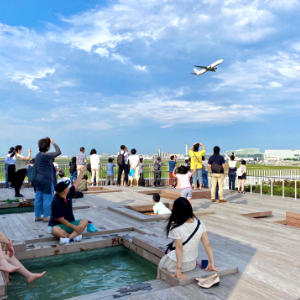Taking the next steps
The Kajima Corporation’s Atsushi Kato explains how Haneda Innovation City will usher in a new era of robots, self-driving cars and immersive experiences
Haneda has long been home to innovation. Tokyo Airfield was established here in 1931 when the area was still a fishing village, meaning the latest planes flew above people farming nori seaweed below. After the war, the airfield developed into Haneda Airport, a gateway to Japan, which over the years expanded offshore, reclaiming land from the sea. The airport’s steady offshore migration has freed up space and in 2020 it was announced that this land would be put to good use – it’s being redeveloped as Haneda Innovation City, a new town designed to epitomize the innovative spirit of the area.
“There was really nothing here; it was a frontier,”
Build for the future
“There was really nothing here; it was a frontier,” explains Atsushi Kato, General Manager of the Kajima Corporation’s Real Estate Development Division, which is in charge of developing the site. “In terms of urban development, this is a rarity. Usually, there’s already things like houses, universities, hospitals, and commercial facilities. We decided to create a new town in a location that lacked even basic infrastructure.” Rather than being intimidated by this blank slate, Kajima saw an opportunity to build a town ready for tomorrow – a smart city with the infrastructure in place for the next generation of technology.
“This will be an environment where robots and self-driving cars can operate freely,” says Kato. In practical terms this means planning a city with space for autonomous vehicles to operate safely away from pedestrians. It also required the installation of about 400 beacons needed for the robots that will eventually work on the streets, making deliveries, cleaning, and patrolling the area. “These beacons are used to indicate the current positions of robots, vehicles, and administrative staff on the premises,” explains Kato. “From the robot’s point of view, these beacons obtain position information to control which path to travel on and where to go to provide a certain service.”
“Automated movement will become a very natural part of our lives just as [smart speakers such as] Alexa have become so pervasive,”
Automatic for the people
While a world of metal mailmen and driverless taxis might seem like a vision of a far-flung future, Kato believes it is closer than many realize. “Automated movement will become a very natural part of our lives just as [smart speakers such as] Alexa have become so pervasive,” he says. “For example, we already have ideas about how in the future you could sit in a wheeled vehicle and nap as it takes you to work.”
But there are hurdles to overcome before we get to Kato’s brave new world. “Robots have a lot of types of eyes,” he says. “They use radio waves, magnetic fields, GPS, and cameras for spacial recognition to save shapes. Each one of them works according to different standards. There is no unified standard, so if robots with different standards come across one another, they will get stuck. So we have to create an environment in which a variety of robots can work under a unified management system. That’s what we’re doing at Haneda Innovation City. We’re trying to create an environment where multiple robots can operate at the same time, and offering it as a single package, so it can be provided to other cities as well.”
“We took a close look at what gives rise to innovation and came to the conclusion that we should simply offer a place where you can achieve whatever you want.”
Ingredients of innovation
There is more to the area than pure science. Kato promises that alongside the on-site hydrogen station and development bases there will be facilities with a focus on the future of food and culture. Haneda Mukashibanashi Yokocho, for example, is a next-generation restaurant offering contemporary twists on Japanese staples such as unagi (eel) and sushi.
Kato hopes this mix will attract start-ups and technology companies from both Japan and the wider world because he believes that ultimately it is people rather than technology that will drive the change he wants to see. “This place should serve as just the core ingredients,” he says. “We took a close look at what gives rise to innovation and came to the conclusion that we should simply offer a place where you can achieve whatever you want.”
PHOTO CREDIT: KISA TOYOSHIMA | Haneda Future Development Co.,Ltd
Ready for tomorrow
Haneda Innovation City is due to open in 2022, but some attractions have already opened…

The autonomous bus
This driverless bus – it doesn’t even have a steering wheel – has been in operation since September 2020. Using Navya Arma technology, it has already transported 10,000 people without any accidents. What’s more it’s free, so there’s no excuse for not taking a ride into the future.
1-1-4 Haneda Airport, Ota, Tokyo haneda-innovation-city.com/en

Haneda Dejima
This incredible, experience-based arts space combines physical feats with digital elements to create a new type of performing arts. The members of the audience, all wearing Magic Leap 1 virtual reality glasses, move between rooms and witness incredible acrobatics and sword fights unfold in front of vivid virtual projections for an immersive experience. Tickets are ¥3,850 (¥1,650 for children).
Zone E 2F, Haneda Innovation City, 1-1-4 Haneda Airport, Ota, Tokyo hanedadejima.jp

Footbath Skydeck
There are many places in Tokyo where you can enjoy foot baths, but you would be hard-pressed to find another one where you can watch airplanes in flight at the same time. At Footbath Skydeck you can treat your feet while Haneda’s latest arrivals fly overhead. The baths are free while vending machines sell towels for ¥500 alongside drinks, so you can just turn up and enjoy the experience.
Zone E rooftop, Haneda Innovation City, 1-1-4 Haneda Airport, Tokyo haneda-innovation-city.com/en